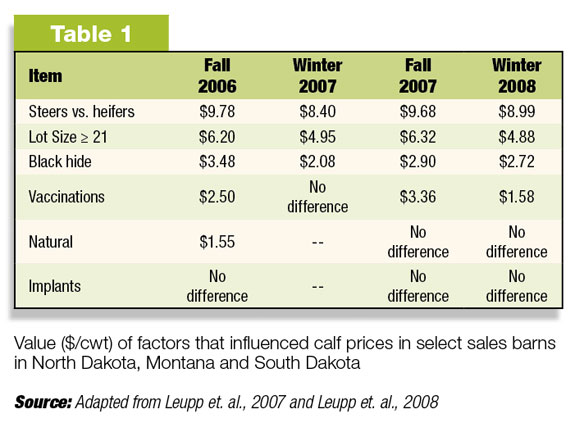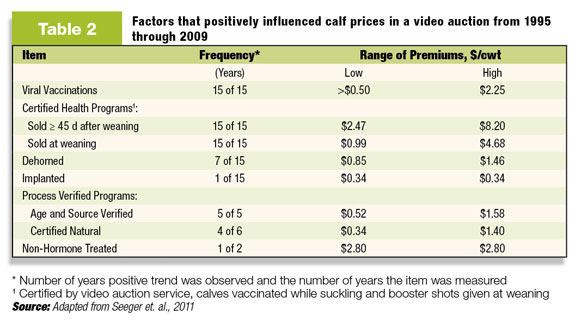Some factors that influence prices are the result of years of careful breeding and management within a herd, whereas the proper use of routine management procedures within a single year can also add value.
Though weaning time may seem to be something in the distant future, planning and reviewing your marketing strategy now can pay big dividends at sale time.

Lot characteristics
Several studies have been devoted to evaluating sales price of calves both in traditional livestock auction markets (18,211 lots containing 197,890 calves) and in video auctions (41,567 lots containing a total of 5,042,272 calves).
As expected, time of year, calf weight, calf sex and region of origin all played a part in prices received. In addition, increasing the number of similar cattle in a draft through the auction ring increased the sale price, with lots of 21 calves or more receiving the best prices (Table 1).
This effect also was seen in the video auction, where prices increased as the weight of single lots approached semitrailer capacity (50,000 pounds).
Predominantly black-hided cattle received the best prices and lots were discounted if variations in color, weight and/or frame size were present.
Groups of producers may be able to take advantage of these trends by commingling their calves of similar weight, frame, finish and color prior to sale to form 50,000-pound lots.
Health protocols
Sound health protocols are essential to the health of commingled cattle upon arrival in the feedlot and they also can reap rewards for the producers that take the time to properly administer vaccinations before calves leave the ranch.
During three of the four sales seasons evaluated, the prices received for calves sold in auction markets that were vaccinated were greater than those received for unvaccinated calves (See Table 1).
Calves that were vaccinated in video auction lots also received greater prices during 15 of the 15 years evaluated, compared with calves that were not vaccinated (Table 2).
Calves that received at least one viral vaccination received from 50 cents to $2.25 per hundredweight (cwt) more than those that did not receive any vaccinations.
However, cattle that received one of two health protocols certified by the video auction group received greater premiums for their calves.
The greatest increase was seen for calves that received a certified health program and had been weaned at least 45 days prior to shipment.
These types of calves are very appealing to feedlot operators because the calves know how to eat from bunks, find water and already have lived through their greatest health challenges.
Implants
The use of implants in calf lots on the video auction fell from 64.3 percent in 1995 to 26.2 percent in 2007.
Many producers have the perception that implants cause a reduction in sales price. However, the sales price of calves that received implants was equivalent to or greater (one year only) than that of calves that did not receive implants in all years studied.
Purchasing and using implants in suckling calves could be a great way for producers to obtain a very favorable return on investment. The exception would be if the premium being received for selling natural cattle is greater than the additional value of pounds added from implants.
Process verified programs
Calves qualified for a natural program that sold in sales barns received a premium ($1.55 per cwt) in one of the three seasons evaluated and calves that were Certified Natural through a USDA- approved process verified program (PVP) received greater prices in four of six years, compared with calves that were not Certified Natural.
It is important to point out that calves receiving these premiums went through the entire process outlined by their respective PVP.
Calves can meet all of the requirements for certification but would only receive the potential premiums if all of their records are in order, they contact a certification agency and follow all of the steps outlined by the PVP.
Click here for a list of USDA-approved PVPs, along with contact information and claims certified.
Another type of certification governed by a PVP is age and source verification, which resulted in increased prices in each year evaluated (2005 to 2009).
Many of us read articles last winter talking about the future of Japan’s 21-month age limit for imported cattle and whether this would be increased to 30 months and eliminate potential premiums for age-verified and source-verified cattle.
At the time of this writing, the future of age and source verification is in question, so all we can do is be prepared. Speak with a PVP provider, make sure all of the records required to obtain age and source verification are in place and carefully weigh your options when we get closer to the fall season.
Other considerations
The importance of flexibility with your marketing cannot be overstated. Talk with your auction market staff or others involved with your marketing strategy and ask questions about markets.
Questions about feedyard preference for calves, status of calf supply and demand, whether feedlots are running at capacity and the latest market trends are all part of the daily conversation for personnel from auction markets, video auctions, Internet sales, etc.
In all cases, consign cattle well in advance of the sale and let the staff of the marketing outlet know as much about the calves as possible.
For example, what color they are, when they were born and vaccinated and whether they are age-verified and source-verified. The more information the market outlet has, the better job it can do of marketing those calves.
Many factors influence the price received for calves at the time of sale. Knowing these factors can allow producers to adopt management strategies that will increase the likelihood of favorable sales prices.
Once this is consistently accomplished and the calves have performed well in feedlots, an additional and very real factor comes into play: repeat buyers.
Herds that have a history of keeping the next person in the production chain in mind by producing healthy, high-performance calves have an advantage in terms of buyer interest that is unrivaled by strategies applied within any single year.
I wish you all the best in developing your marketing plan and hope that you are rewarded with extra bids at sale time! ![]()
References have been omitted but are available upon request. Click here to email an editor.
PHOTO
Groups of producers can use various price trends by commingling their calves of similar weight, frame, finish and color prior to sale to form 50,000-pound lots. Photo by Progressive Cattleman staff.
Carl Dahlen
Extension Beef Cattle Specialist
North Dakota State University













